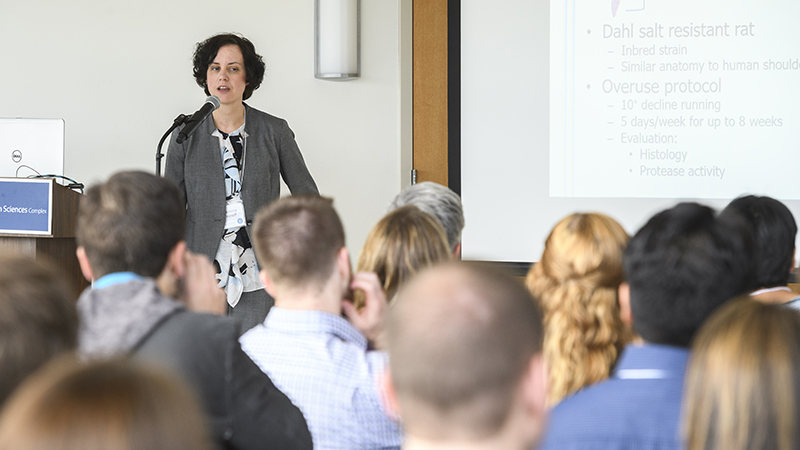


Biomechanics Research Symposium
Photo by Kathy F. Atkinson May 25, 2017
14th annual event features keynote, ongoing research in biomechanics
More than 100 people turned out for the 14th annual Biomechanics Research Symposium at the University of Delaware STAR Campus on Friday, May 12. The event was hosted by the Center for Biomechanical Engineering Research, the Department of Mechanical Engineering and the Delaware Rehabilitation Institute.
The program included 39 posters and 10 podium presentations organized into two tracks: cell/tissue biomechanics and rehabilitation biomechanics. Student presenters represented a range of disciplines and departments across health sciences and engineering.
“It was great to see such a diverse range of research topics presented at the symposium, covering biomechanics and biomechanical engineering at different size scales,” said Mike Santare, director and founding member of CBER.
“CBER has really grown into a multidisciplinary center involving students and faculty from a broad range of disciplines across campus.”
Keynote address
Johnna Temenoff, professor in the Coulter Department of Biomedical Engineering at Georgia Tech and Emory University, delivered the keynote lecture, “Characterizing Structural and Biochemical Changes to Joint Tissues During Rotator Cuff Injury.”
Temenoff, who is also co-director of the Regenerative Engineering and Medicine Center, outlined the timing of changes in proteolytic activity after tendon injury and discussed her group’s work on the development of biomaterials-based strategies to treat joint degeneration.
Stanley Family Foundation Gift
An important item in this year’s agenda was the presentation of the Stanley Family Foundation gift of $20,000 in memory of Vincent Baro, a former CBER student whose life ended too early.
“I am grateful that the Baro family set up this undergraduate research fellowship in CBER,” said Liyun Wang, incoming CBER director and one of Mr. Baro’s former advisers. “Vincent enjoyed doing research, and he had long-lasting impacts on the field by publishing three papers and several conference abstracts, all accomplished in two years.”
In honor of Mr. Baro, CBER will support six summer undergraduate scholars in orthopedic research during the next two years, and a small plaque in memory of Mr. Baro will be hung in Spencer Laboratory.
Awards
Podium Presentation Winners:
Modeling pressure-driven fluid flux and tribological rehydration in articular cartilage (Margot Farnham)
Power imbalance resolved with novel 6 DOF segmental power analysis (Ana Ebrahimi)
Poster Presentation Winners:
Lasers and lubrication: shedding light on how cartilage really works (Brian Graham)
The role of interfacial sliding in mediating the functional performance of articular cartilage (Axel Moore)
Male athletes who walk with gait asymmetries report similar function to those who walk symmetrically one year after ACL reconstruction (Jessica Johnson)
Effect of a real-time biofeedback tool on acclimating individuals post-stroke to wearing personalized passive-dynamic ankle-foot orthoses (Cory Cacciola)
People’s Choice Poster Winner:
A chemogenetic tool to control chondrocyte activity in vitro (Ryan McDonough)
About the Center for Biomechanical Engineering Research
CBER is an interdisciplinary center that combines engineering science and clinical technology to reduce the impact of disease on individuals in their everyday lives. Research topics in the center — which is a joint effort among the departments of mechanical engineering, physical therapy, biological sciences, and kinesiology and applied physiology — range from modeling the neural control of limb movements, to engineering of medical and surgical devices, to the use of functional electrical stimulation and robots in rehabilitation following stroke, to the understanding, prevention and treatment of osteoarthritis.
Contact Us
Have a UDaily story idea?
Contact us at ocm@udel.edu
Members of the press
Contact us at 302-831-NEWS or visit the Media Relations website

